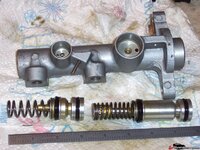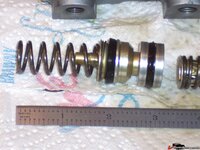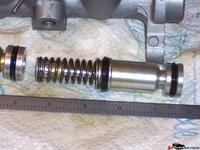I looked around the net for a rebuild kit for a C5 brake master cylinder and found that there are no rebuild kits and that a replacement is waaaaaaay to expensive. It got me thinking about what was so special that some of the replacements sell for $300. So, naturally, I had to see what is inside.
What I found is a pretty conventional master cylinder with the exception of a pressure "delay" built into the front port with a spring in between the rear seal and the front seal. So when you push the pedal, the rear port is directly coupled to the pedal and the front port is coupled to the rear piston with a spring. The spring takes about 30-40 lbs to completely bottomed out where the front and rear pistons are directly coupled to the pedal.
So it looks like the front port (which I assume go to the front brakes) only receive full pedal pressure AFTER the rear port.



What I found is a pretty conventional master cylinder with the exception of a pressure "delay" built into the front port with a spring in between the rear seal and the front seal. So when you push the pedal, the rear port is directly coupled to the pedal and the front port is coupled to the rear piston with a spring. The spring takes about 30-40 lbs to completely bottomed out where the front and rear pistons are directly coupled to the pedal.
So it looks like the front port (which I assume go to the front brakes) only receive full pedal pressure AFTER the rear port.




